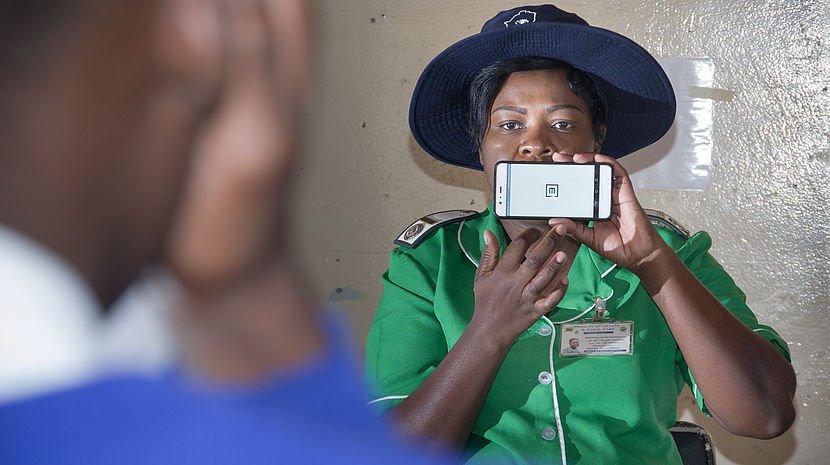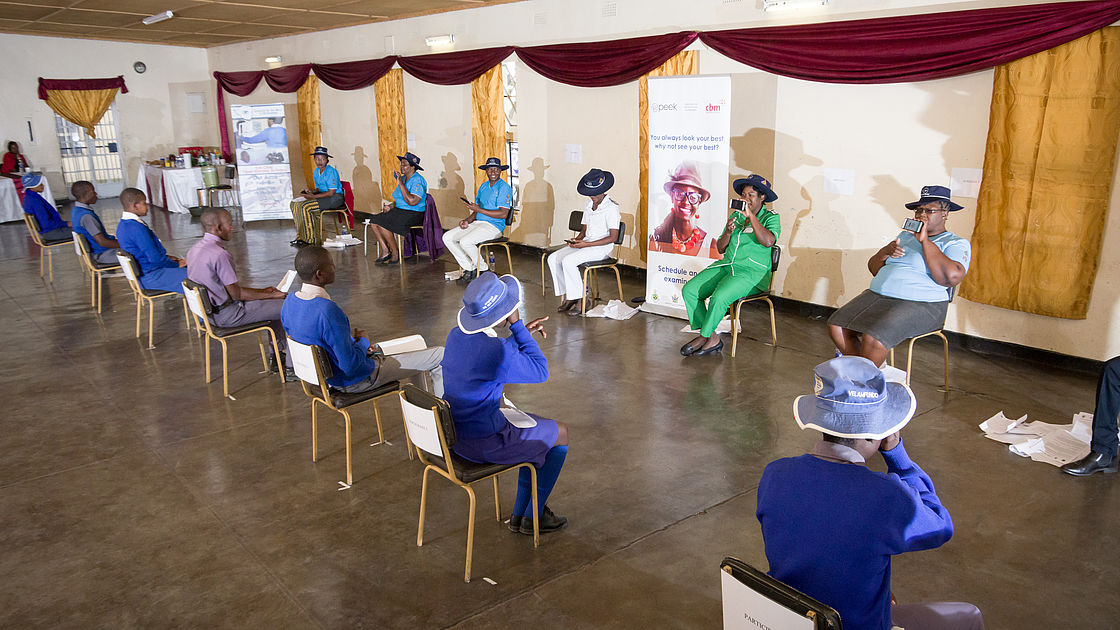Saving Eyesight with Innovative Technology

Which way does the 'E' point? Vision tests being conducted in Zimbabwe.
© CBM/U. Kleiner
Since 2018, CBM is working in partnership with the social enterprise organisation Peek Vision Ltd. to carry out visual acuity tests (test to determine whether each eye can see clearly) using a smartphone, thus enabling us to reach people in the most remote regions of CBM project countries.
In developing countries, many visually impaired people never see a doctor. They often live in remote areas - and the nearest clinic or hospital is usually too far, or the journey too expensive. Visual defects can often be corrected through early detection. According to the World Health Organization (WHO), there are currently around 2.2 billion people worldwide with some form of visual impairment. Almost every second case could have been prevented or is still treatable with the right support.
A new technology that enables quick screening can help eliminate this problem - all you need is an Android smartphone and an app. This innovative method helps identify poor eyesight in good time, thus allowing for early intervention where possible.
Training ordinary people
Using the app developed by Peek on a mobile phone, trained non-specialists can conduct a visual acuity test to screen a patient. The method displays an “E” on the smartphone screen. During the examination, the patient sits across from the cell phone user and is asked to point with their hand in the direction in which the E is "open". This test is sufficient to detect poor eyesight and to decide whether glasses could help the patient or if further examinations are necessary. The application is mainly used in schools, but also in community health centres. Teachers or health workers can carry out the eye tests themselves after a training. In this way significantly more people, especially in remote regions, can benefit from an eye examination in the future.

A school screening event for the Peek Vision pilot project in Zimbabwe.
© CBM/U. KleinerCross-linking different worlds
This innovative cooperation combines the know-how of both sides: as a specialist organisation for inclusive development work, together with its local partners on site, CBM makes sure that the tests are carried out properly and the patients then receive appropriate treatment, thus ensuring effective implementation. Peek, on the other hand, provides the technical know-how, has developed the software for the mobile phone eye test and is supporting the project in an advisory capacity. A collaboration that not only works across national borders, but also cross-links the expertise that both sides bring. The common goal of the cooperation is to combat avoidable blindness in developing countries through better ophthalmic care that is accessible and affordable for everyone.
At the same time, this innovation contributes to strengthening the local health systems on-site. The project has already been launched in Pakistan, Zimbabwe and, more recently, Uganda. To this end, many health care workers in the communities have received appropriate training. About 5000 people are now being tested every week in Pakistan alone. The project will soon launch in Ethiopia, Kenya, and Tanzania this year. The aim is to extend the screenings to more CBM project countries in the long-term.
A lesser burden for ophthalmologists
Under this innovative method, those who do not see well are tested more closely by an optician. A doctor then only examines those patients who have more complex eye problems and need more than glasses. This has lessened the burden on the few ophthalmologists in our project countries – a welcome change, because in many developing countries there is a shortage of skilled workers. In Pakistan, for example, there is one ophthalmologist for every 100,000 people. In comparison, Germany has one per 12,500 people.
But the application offers a lot more: for example, reminding patients of their eye appointments via SMS. This method can also be used to determine how many people are actually taking part in the follow-up exams - which is a critical factor in measuring the success of the project.